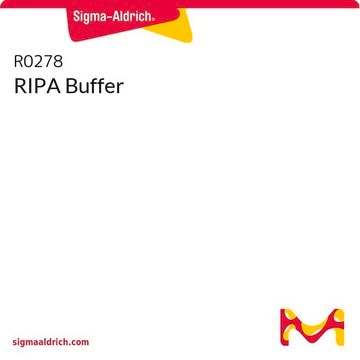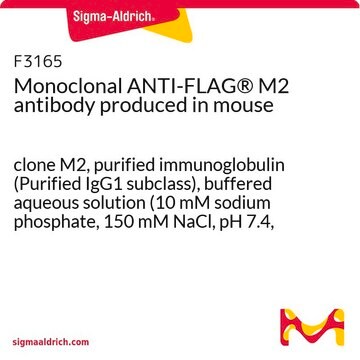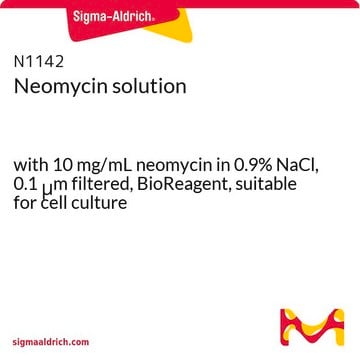If this product has an expiration or retest date, it will be shown on the Certificate of Analysis (COA, CofA). If there is no retest or expiration date listed on the product's COA, we do not have suitable stability data to determine a shelf life. For these products, the only date on the COA will be the release date; a retest, expiration, or use-by-date will not be displayed.
For all products, we recommend handling per defined conditions as printed in our product literature and website product descriptions. We recommend that products should be routinely inspected by customers to ensure they perform as expected.
For products without retest or expiration dates, our standard warranty of 1 year from the date of shipment is applicable.
For more information, please refer to the Product Dating Information document: https://www.sigmaaldrich.com/deepweb/assets/sigmaaldrich/marketing/global/documents/449/386/product-dating-information-mk.pdf
Kluczowe dokumenty
P9620
Puromycin dihydrochloride
Ready Made Solution, from Streptomyces alboniger, 10 mg/mL in H2O, suitable for cell culture
Synonim(y):
3′-(L-α-Amino-p-methoxyhydrocinnamamido)-3′-deoxy-N,N-dimethyladenosine dihydrochloride, Stylomycin dihydrochloride
Wybierz wielkość
1410,00 zł
Wybierz wielkość
About This Item
1410,00 zł
Polecane produkty
pochodzenie biologiczne
Streptomyces alboniger
Poziom jakości
typ
for cell culture
Próba
>98% (HPLC)
Formularz
solution
warunki przechowywania
(Store in cool place. Keep container tightly closed in a dry and well -ventilated place. )
stężenie
10 mg/mL in H2O
metody
cell culture | mammalian: suitable
kolor
colorless to yellow
rozpuszczalność
H2O: soluble 10 mg/mL
spektrum działania antybiotyku
Gram-positive bacteria
neoplastics
parasites
Tryb działania
protein synthesis | interferes
Warunki transportu
wet ice
temp. przechowywania
−20°C
ciąg SMILES
Cl.Cl.COc1ccc(C[C@H](N)C(=O)N[C@H]2[C@@H](O)[C@@H](O[C@@H]2CO)n3cnc4c(ncnc34)N(C)C)cc1
InChI
1S/C22H29N7O5.2ClH/c1-28(2)19-17-20(25-10-24-19)29(11-26-17)22-18(31)16(15(9-30)34-22)27-21(32)14(23)8-12-4-6-13(33-3)7-5-12;;/h4-7,10-11,14-16,18,22,30-31H,8-9,23H2,1-3H3,(H,27,32);2*1H/t14-,15+,16+,18+,22+;;/m0../s1
Klucz InChI
MKSVFGKWZLUTTO-FZFAUISWSA-N
Opis ogólny
Puromycin′s structural similarity to the amino acid-bearing end of tRNA allows it to enter the ribosome during protein synthesis, bind to the nascent polypeptide chain, and halt chain elongation. Widely used in cell culture, puromycin serves as a selective agent for cells that have been transformed with a gene conferring resistance to puromycin.
Zastosowanie
Działania biochem./fizjol.
Mode of Resistance: Puromycin acetyltransferase is an effective resistance gene.
Antimicrobial Spectrum: This product is active against gram-positive microorganisms, less active against acid-fast bacilli and more weakly active against gram-negative microorganisms. Puromycin can prevent growth of bacteria, protozoa, algae and mammalian cells and acts quickly, killing 99% of cells within 2 days.
Cechy i korzyści
- High-quality antibiotic suitable for multiple research applications
- Antibiotic and protein synthesis inhibitor
- Effective against prokaryotic and eukaryotic cells
- Inhibits protein synthesis by interfering with RNA function
- Commonly used as a selective agent in cell biology research
Uwaga dotycząca przygotowania
Inne uwagi
produkt podobny
Kod klasy składowania
10 - Combustible liquids
Klasa zagrożenia wodnego (WGK)
WGK 2
Temperatura zapłonu (°F)
Not applicable
Temperatura zapłonu (°C)
Not applicable
Środki ochrony indywidualnej
Eyeshields, Faceshields, Gloves, multi-purpose combination respirator cartridge (US)
Wybierz jedną z najnowszych wersji:
Certyfikaty analizy (CoA)
Nie widzisz odpowiedniej wersji?
Jeśli potrzebujesz konkretnej wersji, możesz wyszukać konkretny certyfikat według numeru partii lub serii.
Masz już ten produkt?
Dokumenty związane z niedawno zakupionymi produktami zostały zamieszczone w Bibliotece dokumentów.
Klienci oglądali również te produkty
Produkty
Small interfering RNAs (siRNAs) are powerful tools for gene expression knockdown, widely used in molecular biology.
Lentiviral vector systems prioritize safety features, with design precautions preventing replication. Good handling practices are essential for use.
Systemy wektorów lentiwirusowych mają priorytetowe znaczenie dla bezpieczeństwa, a środki ostrożności zapobiegają replikacji. Dobre praktyki obsługi są niezbędne do użytkowania.
Get tips for handling lentiviruses, optimizing experiment setup, titering lentivirus particles, and selecting helpful products for transduction.
Protokoły
Determine optimal antibiotic concentration for stable cell lines, ensuring efficient selection in transduced cells.
This detailed procedure allows you to transduce Mouse Embryonic Fibroblasts (MEF) using MISSION ExpressMag Super Magnetic Kit.
Lentivirus versions of genome modification technologies support successful CRISPR, RNAi, and ORF experiments.
FACS sorts cells based on light scattering and fluorescence for objective cell analysis.
-
How can I determine the shelf life / expiration / retest date of this product?
1 answer-
Helpful?
-
-
How is shipping temperature determined? And how is it related to the product storage temperature?
1 answer-
Products may be shipped at a different temperature than the recommended long-term storage temperature. If the product quality is sensitive to short-term exposure to conditions other than the recommended long-term storage, it will be shipped on wet or dry-ice. If the product quality is NOT affected by short-term exposure to conditions other than the recommended long-term storage, it will be shipped at ambient temperature. As shipping routes are configured for minimum transit times, shipping at ambient temperature helps control shipping costs for our customers. For more information, please refer to the Storage and Transport Conditions document: https://www.sigmaaldrich.com/deepweb/assets/sigmaaldrich/marketing/global/documents/316/622/storage-transport-conditions-mk.pdf
Helpful?
-
Active Filters
Nasz zespół naukowców ma doświadczenie we wszystkich obszarach badań, w tym w naukach przyrodniczych, materiałoznawstwie, syntezie chemicznej, chromatografii, analityce i wielu innych dziedzinach.
Skontaktuj się z zespołem ds. pomocy technicznej










